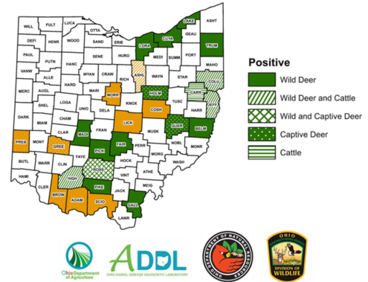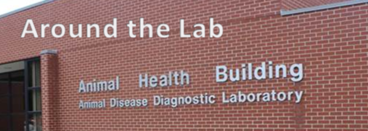 Chronic Wasting Disease Update
Dr. Jeff Hayes, MS, DVM, ADDL Pathology Section Head
Through November 2017, the ADDL has performed
immunohistochemistry (IHC) to detect the prion agent associated with Chronic
Wasting Disease (CWD) in tissues from 1,585 captive deer and from 411 wild
deer this year. The majority of the wild deer were submitted by the Ohio Division of Wildlife.
To date this has included the examination of 7,100 tissues. No suspect or positive animals have been
detected among all deer tested in 2017, and none have been detected in Ohio since
two premises were identified as having CWD-infected captive white-tailed deer
in late 2014 and early 2015.
 Dr. Jeff Hayes, MS, DVM, ADDL Pathology Section Head
Epizootic hemorrhagic disease (EHD) in deer and cattle
Twenty five animals in Ohio – 19 white-tailed deer and 6 cattle – in 18 counties were confirmed to be infected
with EHD virus by either PCR, virus isolation or serologic testing
between August 7 and October 18, 2017. Serotyping was completed on seventeen of the 25 deer cases and one cattle case; all were
identified as type 2 EHD virus.The majority of confirmed infected deer were wild (14). Five infected while-tail deer were from captive herds located on three premises. Counties with infected deer this year included Belmont, Columbiana, Cuyahoga, Fairfield, Gallia, Guernsey, Highland, Holmes, Jefferson, Lake, Lorain, Madison, Pickaway, Pike, Ross and Trumbull.
The 6 cattle cases were from 4
counties (Carroll, Columbiana [2], Highland and Jefferson [2]). Four of the cases prompted foreign animal disease investigations resulting in the testing of blood and oral
swab samples at the Plum Island Foreign Animal Disease Diagnostic Laboratory.
All affected cattle recovered from their illness.
Practitioners are reminded that clinical signs of EHD including anorexia, salivation and oral
erosions in cattle may mimic
reportable ones such as
foot and mouth disease, bluetongue and vesicular stomatitis. Veterinarians should
report such cases to the office of the State Veterinarian (614-728-6220) or the
USDA Area Director (614-856-4735). Cases for this year are expected to subside as several
frosts have occurred, which will decrease the population of Culicoides midges
that transmit this virus to susceptible hosts. Note that this virus is not
zoonotic.
 Note that green colored counties are POSITIVE for EHD infected animals (see legend). Orange colored counties had negative test results.
West Nile Virus (WNV) Update
During the summer and autumn of 2017, a total of 14 horses
in Ohio were confirmed by the National Veterinary Services Laboratories (NVSL) as having IgM serum titers consistent with
West Nile virus (WNV) infection. Dates of onset were between 8/24/17 and
10/18/17, with 4 cases in August, 7 in September and 3 in October. Ages ranged
from 10 months to 20 years. Breeds affected included 8 Standardbred, and one each Belgian, Dutch Harness Horse, Haflinger,
Percheron, Thoroughbred, and one was unknown. Eight horses were male, 5 female,
and for one case gender was not reported.
Affected horses were from 9 counties: Ashland, Ashtabula, Columbiana
(2), Geauga, Holmes, Licking, Logan (2), Tuscawaras and Wayne (4). Note that
three counties had multiple cases, with 4 infected horses from Wayne county. Clinical signs reported among the affected horses
included weakness of front or rear or all four limbs, incoordination, wobbling
of the head, hypersensitivity to sound, sight and touch, muscle fasciculations,
inability or refusal to eat or drink, variable fever up to 103 F, and
recumbency or inability to rise.
While six horses were reported to
have survived the infection, six were euthanized for seriousness of clinical
signs, and 2 horses died spontaneously. Eleven of the 14 case were reported to have not been vaccinated for WNV. In the three other cases, the vaccine history was
not known. These cases point out the need to provide vaccination to prevent
illness and death in horses that could be exposed to infected mosquitoes.
Eastern Equine Encephalitis (EEE)
One horse in Ashtabula county, with no reported
signalment, was identified as being infected with eastern equine encephalitis
virus (EEEV) as determined by a high IgM capture ELISA titer performed at NVSL
in August, 2017. The horse had to be euthanized due to poor prognosis of severe
CNS signs, and was reported as not being vaccinated against this mosquito-borne
virus. Ashtabula county was the only county to have reported cases of both WNV
and EEE infections in horses in Ohio in 2017. It is important to remember that
both viruses are capable of causing severe illness and death in humans, as well
as in horses, so control measures to limit mosquito populations on premises and
in communities are important for both human and animal health. Furthermore, EEE infections in horses are
reportable to the State Veterinarian office by state law. Call 614-728-6220 to
report suspect and confirmed cases.

 Melanie Prarat, MS, ADDL Virology Section
Veterinarians and labs are always looking for ways to improve in sampling and diagnostic techniques. The use of blood pooling techniques and oral fluids are examples of such improvements.
Research at the University of Minnesota has demonstrated that processing fluid (PF), the liquid accumulated at the bottom of a pail during routine piglet tail docking or castration procedures, is an acceptable sample type for same-day PRRS virus testing. The ADDL now accepts PF for PRRS testing. It is a sensitive, inexpensive, convenient sample type for assessing PRRS status in a sow herd, and it takes advantage of procedures already routine in farrowing rooms.
In addition to same-day testing, it is also possible to recover and sequence PRRSV from the PF samples. Please make sure to include on your submission form if you would like these additional tests added.
|
 The Ohio ADDL will be closed on Monday, December 25, 2017 in observance of Christmas, and Mondary, January 1, 2018 in observance of New Year's Day. Have a safe and enjoyable holiday.
For additional information and resources, please visit our website. If you need to contact us regarding an urgent matter, please use our after hours phone number: (888) 456-3405.
|